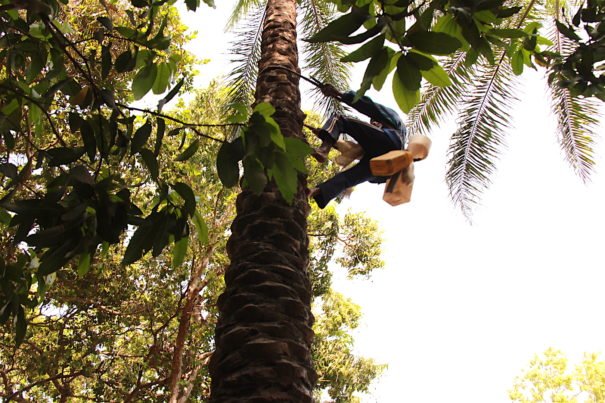
Everyone Should Have a “Palm Wine Guy”

Everyone Should Have a “Palm Wine Guy”
Palm Wine in Senegal
As we walked along the only paved road that ran parallel to the river in search of “the palm wine guy,” the haze from the sweltering spring day in southern Senegal blurred the faces of the women working in the wheat fields either side of us.
Locals in Ziguinchor’s city center told my friend, Ousmane, and I that we had to try palm wine while in Casamance, and that the best came from a guy in Boutoute, a village a little over two miles away. So we walked. We turned off the paved road and walked down the dirt path past the crocodile swamp toward the forest of palm, mango, and lemon trees. The forest was thick, dark, and moist underfoot as we trudged forward under the shadow of palms and the buzzing of horse-flies and bees.
The few villagers we met along the way directed us to the front door of a one-story, mud-brick dwelling—the home of Jean-Paul Badji, the man behind the palm wine. We told him what we were after, and with a sweet smile spread across his aging face, he pulled out a two-gallon jerry can and two aluminum cups and offered us a drink.
The wine was warm and sweet on my tongue, with a bit of tang. I watched the white, frothy liquid—which the local Jola people call Boulouk—slowly disappear from my cup.
Newly tapped palm wine has no real alcohol content, but after about an hour of fermenting, it turns into wine with 4 percent ABV. It left us feeling a slight buzz. The longer the wine ferments, the stronger it becomes—reaching its maximum proof of 40 percent ABV before it turns to vinegar.
Excited by our discovery and also wanting a decent stock for the evening, we asked for some for the road. Jean-Paul told us we had just finished the last of his morning stock, but that we could accompany him on his afternoon route to collect the last batch of the day.
Boulouk seeps out of the hole created by cutting away the three-pound clusters of crimson fruit kernels that grow near the top of the African oil palm. The trees can grow up to 100 feet tall, which makes obtaining the palm wine no easy task. Nonetheless, locals say their ancestors have been climbing palm trees and drinking their wine for thousands of years.
That night under the stars, we gathered with Jean-Paul’s family of 13 and his neighbors at the path’s crossroads outside the forest, and drank palm wine while we shared stories by the fire. By night, the wine was stronger, spurring laughter from all of us. It was a great way to toast to the night after a long day. Because the ingredients are just tree sap, we didn’t have to worry about a hangover in the morning.